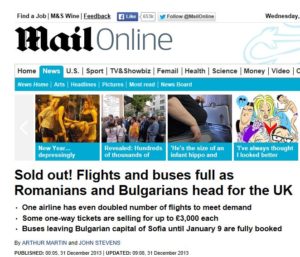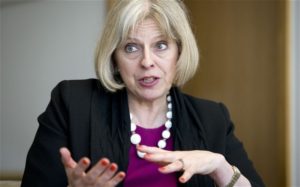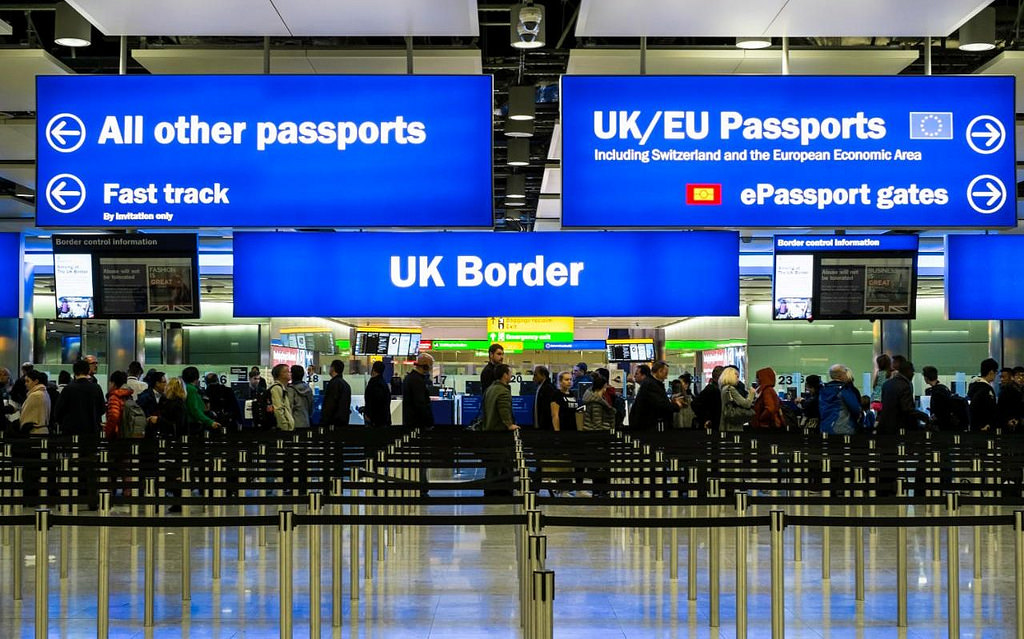Rob McNeil, Deputy Director of the Migration Observatory outlines a decade-long obsession with a vague number - the net migration target of 'tens of thousands'.
The 2010s in the UK have been characterised by an experiment in migration policy and populist rhetoric that may have failed, but also critically reshaped the nation. The net migration target.
From a migration perspective, we can bookend the last decade with two key political moments that marked the beginning and the end of an era in British politics that was defined by the relentless pursuit (or at least the illusion of the relentless pursuit) of an oddly vague but at the same time very specific number – ‘the tens of thousands’.
One bookend is David Cameron’s appearance on the Marr show on the 10th of January 2010, the other the announcement of the election of Boris Johnson on Friday 13th December 2019.
The Marr Show and the 2010 election
Cameron’s appearance on the Marr show saw this young and dynamic party leader - at that point the leader of the opposition – introduce the concept of ‘net migration’ to the British public, and our first suggestion that it should be limited to the ‘tens of thousands’ rather than the hundreds of thousands.
This step was important for a number of reasons. It created, for the first time in the UK, the concept that there was a ‘right amount’ of migration to and from the country.
More importantly, it was a major strategic public relations win. The target reframed migration control as a technocratic process of simply balancing the books. With the Conservatives having languished in opposition for 13 years Cameron had spent the years since he took the helm of the party trying to shake off the “nasty party” epithet coined by Theresa May (of whom, more later…) in 2002. He’d ‘hugged hoodies’ and then hugged huskies, and generally bolstered his credentials as a ‘compassionate Conservative’. Few issues were more toxic for the Tories – the party of Enoch Powell – than immigration.
The Marr show offered Cameron an opportunity to offer something to everyone on immigration. Immigration was, he highlighted repeatedly, a great thing for the UK. The issue he was concerned about was population growth and pressure on public services, so managing that was simply a case of making sure that the net number was about right. The concept of net migration was somewhat obscure at the time – previous policies had been based on controlling immigration and net migration was a technical term used only by a few.
Putting restrictive immigration controls back on the political menu proved extremely effective for the Conservatives in the 2010 election campaign. Gordon Brown’s hot-mic dismissal of long-standing Labour supporter Gillian Duffy as ‘just a sort of bigoted woman,’ when she raised concerns about immigration, damaged him and generated a sense that the Tories could win on an immigration control platform. And they (sort of) did.
2011-12: New migration policies
The coalition years were dominated by the promise to hit the net migration target by the 2015 election. Between 2011 and 2012 policies were introduced to cap skilled non-EU labour migration, close ‘bogus colleges’ and cut abuse of study migration visas, to create a minimum income threshold for people planning to bring a spouse or other family member to live with them and to ‘break the link between immigration and settlement’. Throughout the period, the vote-winning promise of cutting net migration was hammered home again and again by Cameron and his single-minded Home Secretary, Theresa May.
The target often seemed to be the fundamental objective of the Conservative party, and dominated almost all other Government policy decisions. The Liberal Democrats were quick to distance themselves from the policy, and took a back seat on immigration issues, but for the Conservatives the target was a gift that kept on giving. Popular among voters and the right-wing press alike, when net migration levels dropped it was lauded as a success, and when they went up, it was seen as justification for the policy.
Labour, meanwhile, was relentlessly attacked for their ‘failure’ to control immigration. They were depicted as having ‘opened the floodgates’ of EU migration, and of developing immigration policy with the intention to ‘rub the right’s nose in diversity’.
At the time of the 2010 election, COMPAS had been working on the development of a new project, The Migration Observatory. The unit was launched in spring 2011 - at roughly the same time as the announcement of the suite of new immigration policies designed to achieve the net migration target. By June 2011, the team had established that the Government’s own impact assessments showed the net migration target could not be met based on the policies that had been introduced.
2013-14: The Romania and Bulgaria panic
By the beginning of 2013 the new policies had delivered some low-hanging fruit, and net migration appeared to have dropped a little to around 160,000, though the continued economic challenges and reduced job creation may have played a significant role in this.
At this time the press began to focus on the countdown to Romanian and Bulgarian citizens getting full access to the UK labour market on January 1st 2014. Starting in early 2013 apocalyptic headlines began appearing in the newspapers claiming that the borders would be ‘open to 30 million Romanians and Bulgarians’.

When Romania and Bulgaria had joined the EU in 2007 the British press had hardly batted an eyelid (see fig 11 in here). But by 2013 increased awareness of the rapidly growing Polish population in the UK combined with years of austerity and the net migration target had created a sense that EU immigration was now something that was ‘out of control’.
Media narratives also constantly focussed on negative stereotypes of Romanians, highlighting issues of vagrancy, criminality and other anti-social behaviours. This period compounded the reframing of EU migrants in much UK media and policy discourse in a way that would have huge ramifications for the EU referendum a few years later. EU migrants moved from broadly ‘us’ to broadly ‘them’ - from highly skilled, high waged, culturally similar and limited in numbers to low skilled, low waged, different and numerically uncontrollable.
The net migration target and economic recovery amplified concerns further. The dip in net migration after the initial policy changes did not continue, and throughout 2013 and 2014 net migration increased, with data at the time suggesting that by the end of 2014 it had almost doubled from its 2013 dip to 318,000. But while the quarterly statistics released provided ever more challenging data for the Conservatives’ target, concerns about immigration and support for the target remained high, and the government continued to promise to deliver cuts that would hit the increasingly elusive ‘tens of thousands’ target.
The hostile environment and the ‘migrant crisis’
While the policies designed to hit the net migration target may not have been bearing fruit, the Government’s most avid proponent of the policy, Home Secretary Theresa May, continued to push tough rhetoric on all sorts of migration control. In a 2012 Daily Telegraph interview she had introduced what has now become one of the most notorious concepts of the coalition’s time in office – the ‘hostile environment for illegal immigration’.

Credit: Geoff Pugh
Among certain sections of the British public the policy was popular, and worries about irregular migration were high. 2014-16 saw a massive increase in asylum seekers entering the EU from Turkey and Libya after the sudden rise of ISIS in Syria and Iraq, the escalation of Syrian civil war and the continued chaos in Libya. Numerous flimsy boats crossed the Mediterranean, and thousands drowned when many of these vessels sank. Across the EU concerns about migration flows were being raised, and limited border controls were introduced even in parts of the EU’s Schengen zone.
Numbers of asylum seekers looking to reach the UK began to rise in Calais. Just over a decade before the Labour government had pushed the French to close a refugee camp at Sangatte – citing concerns that it was little more than a staging point for migrants to find a clandestine route in to the UK. The closure meant that refugees arriving in Calais in the period around 2014 (and onwards) lacked any proper facilities and ended up living rough. The informal settlement that built up in Calais soon became notorious as ‘the Jungle’.
As the UK border had been placed on the French side of the channel at the time of the closure of Sangatte, those hoping to enter the UK to claim asylum found it increasingly difficult to do so. Desperate individuals attempted to hide in holiday-makers’ cars and in lorries and the reporting of these incidents in the UK media heightened concerns about irregular migration in the UK.
In 2014 the ‘hostile environment policy’ became enshrined in a new immigration act. Policies effectively barred those unable to prove their legal immigration status from access to healthcare, rental accommodation, employment, driving licences and innumerable other day to day activities and government services that allow one to live a normal life – essentially creating a situation where life was so unbearable for these people that they would ‘self deport’.
But popularity of the policy among those concerned about levels of irregular migration in the UK, and the possibility that some irregular migrants were getting a ‘free ride’, masked a lack of evidence that the policies would work without causing harm, and disturbing impacts on a large number of long-term legal residents in the UK – most of whom were from ethnic minorities.
2015: The rise of UKIP and a critical election
Over the course of 2014 it had become increasingly clear that the Conservatives were going to miss the net migration target in a pretty spectacular fashion. Romanian and Bulgarian migration proved a useful explanation for this, and some in Government highlighted the challenges that freedom of movement created for the control of migration. At the time, data strongly suggested that EU net migration was significantly lower than non-EU migration (though this has been called into question more recently), but as the EU’s freedom of movement directive prevents member states from limiting levels of migration from other EU countries, the argument proved compelling.
The point was not lost on the Eurosceptic wing of the Conservative party or, indeed, on UKIP and its leader Nigel Farage, whose burgeoning support among traditional Tory voters was raising significant concerns for Cameron’s government as they moved toward the 2015 election. UKIP was able to promise very tough immigration policies and by committing to remove the UK from the EU would cut migration even further. Though UKIP was unlikely to be able to get anywhere near forming a government, they had the potential to steal enough votes to easily deny the Conservatives a victory. The response of the Conservatives was offer a referendum on EU membership – an offer considered by many to be on the table only because Cameron expected to be in another coalition with the Lib Dems, who would not allow such a thing to take place.
Labour, meanwhile had failed to find a way to escape its reputation as having ‘lost control of the borders’. Ed Milliband had announced that Labour had ‘got it wrong’ on immigration in the Blair-Brown years, and had made various unconvincing effort to argue that Labour would be tougher on migration in the future – including a baffling ‘Controls on Immigration? Vote Labour’ mug – but the party was not keen to engage on the issue in media or policy debates.
As the election neared, the magnitude of the failure to meet the net migration target was becoming obvious. A relatively thriving economy and subsequent job creation had helped push net migration over the 300,000 mark. The issue was electoral kryptonite for both Conservatives and Labour and served only to strengthen UKIP.
But in the end, Cameron secured a surprise majority, and migration, once again, came to the fore in UK’s policy debates.

2016: Referendum mania
As the dust settled after the general election, with the Liberal Democrats decimated, the Scottish National Party rampant, and the Conservatives with an overall majority, Home Secretary, Theresa May surprised many by insisting that the tens of thousands net migration target was still what the Government was aiming for. Despite changing from a firm policy commitment to more of an aspiration, this level of overall net migration was still what the Government deemed to be about right for the country. This was a challenge, as net migration statistics, by this point, indicated that the actual level was over 330,000 per year.
By now, a new issue was on the horizon - the promised referendum on EU membership. After his previous gamble with a referendum on independence for Scotland had paid-off for Mr Cameron in 2014, the EU referendum – which polling at the time indicated seemed likely to be easily won by the remain campaign – was expected to be relatively straightforward.
But as campaigning began in earnest, the gloves were off. Free movement and control of immigration were weapons that the Leave campaign’s chief strategist, Dominic Cummings, had no compunction in using to hit the Remain campaign where it hurt. It is hard to ignore Cummings’ argument that the referendum result, when it came in, showed that mobilising public concerns about EU immigration was a critical factor in the UK’s decision to leave the European Union.
The result was devastating for Cameron, who – despite promises to remain in place to see things through, whatever the result – stepped-down almost immediately after the humiliation of the Remain defeat and the evident divisions that the referendum had exposed in UK society.
Cameron’s successor Theresa May had defied the notorious curse of the Home Office and managed to keep her job as Home Secretary for a full six years, largely on the back of support in much of the press for her flagship policies – the net migration target and the hostile environment. After the apparent self-destruction of much of the Conservative party in the fires of the Brexit referendum, May promised ‘strong and stable’ leadership, and for a time, at least, was riding high - with the Daily Mail praising the ‘Steel of the New Iron Lady’.
The referendum had, however, dented the confidence of the international finance markets, and the pound plummeted in value against the Euro, the Zloty and other currencies. Migrants in the UK - particularly those sending remittances home to their families, were seeing smaller benefits from working here. Meanwhile the Eurozone – which had been in a slump for many years – was recovering, with job creation in other EU member states. This combination would help to drive a sharp fall in EU net migration to the UK – particularly from the new member states.
2017-18: electoral debacle and the Windrush scandal
Realising just how much needed to be done to get Brexit ‘over the line’ meant that suddenly migration was no longer such an urgent issue in parliament or in the press. Public concerns about Europe eclipsed concerns about immigration.
The new Home Secretary, Amber Rudd, surprised many by continuing to support the net migration target, and though net migration was falling at last, attention was now more focussed on what post-Brexit migration policies might look like, how EU migrants would protect their rights to remain in the UK and other Brexit- related issues.
Theresa May’s ill-advised effort to increase her majority and consolidate her ability to push through legislation with an election in May 2017 lost the Conservatives their majority, and led to more than two years of effective paralysis in parliament.
By early 2018, reports had begun to emerge of serious problems facing long-term British residents caught-up in the government’s ‘hostile environment policies’. Guardian journalist Amelia Gentleman, in particular, had interviewed a number of people of Caribbean origin from what has become known as ‘the Windrush Generation’. Most had arrived in the UK in the 60s and early 70s as children, and had been astonished to now find themselves suddenly deemed ‘illegal immigrants’.
They were forced out of their jobs and homes and in some cases into detention, denied cancer treatments, and pushed to the brink of suicide. Legal residents were deported from the UK to countries they hardly knew.
As evidence mounted that these people were legal UK residents, and that Home Office targets appeared to have played a role in driving them into destitution and anguish, a national scandal erupted. Amber Rudd resigned, and was replaced by Sajid Javid as Home Secretary, who immediately set about distancing himself from the ‘hostile environment’ (euphemistically rebranded the ‘compliant environment’), while also putting together a new immigration white paper outlining new policies for the post Brexit period (though whether these survive the Johnson administration remains to be seen).
2019 – Endings
By 2019 Theresa May’s administration was a lame duck. Having negotiated a withdrawal agreement with the EU she was repeatedly defeated in parliament as infighting within her own party created gridlock, and she was eventually forced to stand down as party leader.
With the choice of Boris Johnson as her replacement as Conservative party leader, a new era in immigration policy was ushered-in. The net migration target, was finally dead and in its place was a somewhat vague new concept – the “Australian-style points based system”.
However, placing Johnson at the helm of the Conservative party was not a silver bullet, and the party was in disarray. The ‘confidence and supply’ agreement with the DUP, was in tatters, as Johnson’s negotiations with the EU had effectively ensured a customs border in the Irish Sea after Brexit; pro-European voices in the Conservative party were mutinous – with several leaving to join the Lib Dems. Johnson’s answer to this was to call an election, which – after much wrangling – was won convincingly at the close of the year.
As the decade ended, so too did a period defined by an extraordinary fixation with a vague number - ‘the tens of thousands.’ Now in early 2020 we await the Migration Advisory Committee (MAC)’s review of the Australian immigration system and similar systems to advise on what “best practice can be used to strengthen the UK labour market and attract the best and brightest from around the world”.
The MAC has been asked to report by the end of this month.
